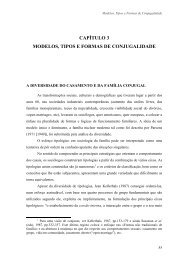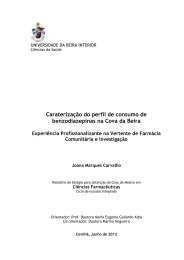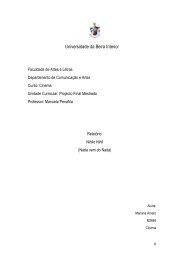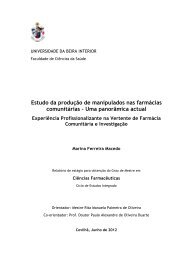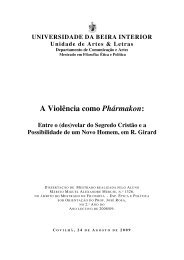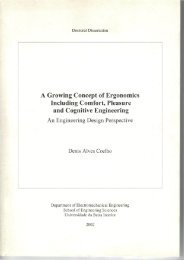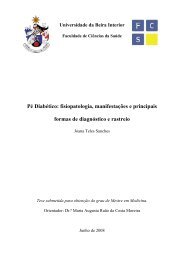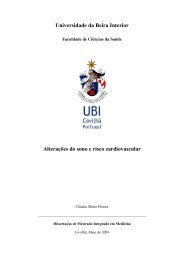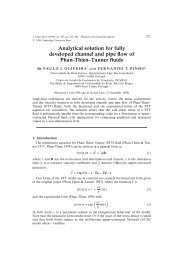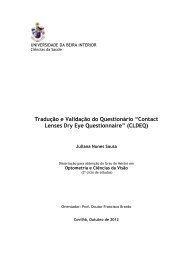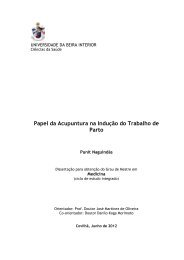Tese_Tânia Vieira.pdf - Ubi Thesis
Tese_Tânia Vieira.pdf - Ubi Thesis
Tese_Tânia Vieira.pdf - Ubi Thesis
You also want an ePaper? Increase the reach of your titles
YUMPU automatically turns print PDFs into web optimized ePapers that Google loves.
Chapter I - Introduction<br />
1. Introduction<br />
1.1. Bacterial infections that affect human beings<br />
Bacterial infections have been a constant threat to human health throughout history<br />
(Vasilev et al. 2010). Human beings are often infected by different microorganisms such as<br />
bacteria, molds, yeasts, and viruses (Shahverdi et al. 2007; da Silva Paula et al. 2009). In the<br />
beginning of the 20 th century, infectious diseases were the main cause of death worldwide (Huh<br />
et al. 2011). Examples of these diseases are the bubonic plague, tuberculosis, malaria, and the<br />
acquired immunodeficiency syndrome pandemic caused by the human immunodeficiency virus<br />
(HIV) that have affected a substantial number of patients worldwide, causing significant<br />
morbidity and mortality (Tenover 2006). In the middle of the 20 th century, the development of<br />
new antibiotics and other methods to control infections helped the humans to prevent and treat<br />
from several diseases (Tenover 2006). All these advances began when Flemming, in 1928,<br />
discovered the first antibiotic that he called penicillin (Ligon 2004). Antibiotics are defined as<br />
chemical substances that are produced by a microorganism, that have the capacity, in dilute<br />
solutions, to selectively inhibit the growth of or to kill other microorganisms (Collier 2004). The<br />
penicillin was extracted from a plant of the genus Penicillium (Ligon 2004) and their commercial<br />
production began in the late 1940s (Kalishwaralal et al. 2010; Huh et al. 2011). The use of<br />
antibiotics had a great success in 70 th and 80 th decades of the 20 th century (Huh et al. 2011;<br />
Prucek et al. 2011), when newer and even strong antibiotics were developed (Huh et al. 2011).<br />
However, the development of antimicrobial drugs contribute to the current crisis in fighting<br />
against multi-drug resistance bacterial strains (Huh et al. 2011), where initially susceptible<br />
populations of bacteria become resistant to an antibacterial agent and proliferate and spread<br />
under the selective pressure of use of that agent, leading to the need of development of new<br />
antibiotics (Tenover 2006; Xu et al. 2011). The mechanisms of antibiotics resistance are spread<br />
in a variety of bacterial genera (Tenover 2006). These mechanisms are the result of the<br />
acquisition of genes encoding enzymes by the organism, such as β-lactamases, that destroy the<br />
antibacterial agent before it can have an effect. Furthermore, the bacteria may acquire efflux<br />
pumps that extrude the antibacterial agent from the cell, before it can reach its target site and<br />
exert its effect. Finally, bacteria may acquire several genes for a metabolic pathway which<br />
produces altered bacterial cell walls that do not present the binding site of the antimicrobial<br />
agent, or bacteria may acquire mutations that limit the access of the antimicrobial agents to the<br />
intracellular target site via downregulation of porin genes (Stewart et al. 2001; Tenover 2006; Xu<br />
et al. 2011). Currently, the treatment of bacterial infections using classical antibiotics is<br />
becoming a serious global health problem (Sondi et al. 2004; Kim et al. 2007; Ghosh et al. 2010;<br />
Liu et al. 2010; Potara et al. 2011; Prucek et al. 2011) due to the fact that most of the<br />
prominent infectious disease agents are resistant to all the antibiotics presently available (Xu et<br />
2




